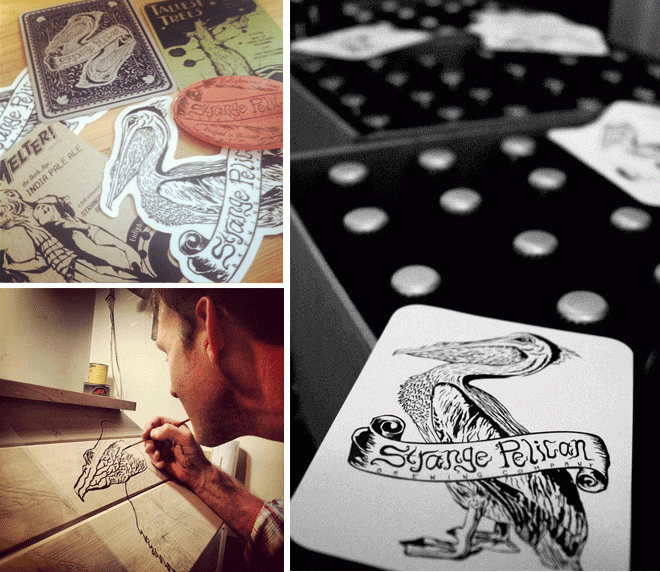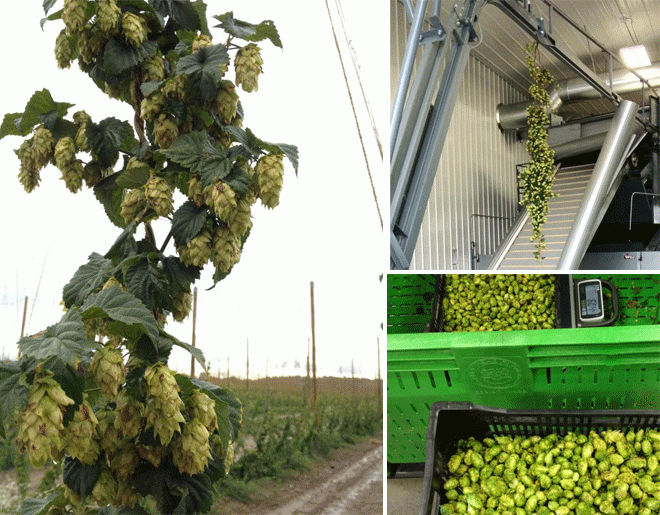
When Doejo co-founder Phil Tadros sees something he likes, he doesn’t waste any time making it a part of his growing entrepreneurial community. Strange Pelican was no exception: after spotting some artfully designed Strange Pelican bottles on display at a local cafe, Tadros reached out to Strange Pelican founder Eric McNeil. After discussing many possibilities—including a brewpub, a diner and a cafe—McNeil and Tadros decided to partner on opening a production facility. Strange Pelican’s plans for a brick-and-mortar space, scheduled to open early next year, have already been featured in the RedEye.
Doejo’s team will be helping to design and develop Strange Pelican’s web presence and handling its social media. So, we thought it was time to learn a little more about the origins of Strange Pelican and what the future holds for the up-and-coming brewery whose image we will be helping to shape. McNeil answers our questions below while giving us a sneak peek into the harvesting process through his recent trip to the Hop Heads Farm facilities in Michigan.
For those who don’t know, tell us how Strange Pelican got started
Strange Pelican started out of my ambition to create what I had become obsessed with in the world of craft brewing: the endless possibilities. Craft brewing can be as simple or as complex as you make it. The idea was born out of experimentation and has thrived because of it. Strange Pelican was launched as an “underground” special event brewery, offering bottled seasonal brews wrapped in uniquely intriguing artwork. While the illustrated themes may change, the beer names remain consistent in their references to timeless jazz and blues legends.
What role will Doejo play in the future of Strange Pelican?
Doejo will be helping to assist in the web presence and social media side of the company and everything that comes with that: amazing website design, marketing, video, all retaining the unique style already associated with Strange Pelican.
Tell us outsiders a little about the harvesting process
The hops are grown up a rope trellis several feet tall, in a vine-like fashion. When harvesting, first we manually go cut down the bine and rope, then we begin to collect a row of hops. After collecting the hops we put them one at a time onto a ski-lift type operation that takes them to the comb-style processor. This processor separates the hop cones from the vine. The separated hops are then dropped onto a system of conveyer belts that take the cones be weighed and sorted.

What were some highlights of the Hop Heads Farm facilities?
Just being able to be part of the process was an amazing experience. You definitely have a lot more appreciation for a product after understanding what happens behind the scenes. A husband and wife team that have a strong background in horticulture and greenhouse growing run the hop farm. They were very open to educating us on everything involved, from planting the rhizomes to drying and packaging the hops.
This harvester looks super impressive! How does it work?
It’s a brand new machine and it is very large. It almost seems a bit excessive when the end result is a hop cone the size of your thumb. Generally, it is used to increase productivity.
What type of beer will you brew from these hops?
I decided to completely embrace the American style of the Pale and Amber Ale, with a very healthy amount of hops added. The wet hops are very seasonal and deserve to be in the spotlight here. When harvesting “wet hops” you can dry and package them or use them in a brew within 48 hours of harvesting. There are certain characteristics you will get out of wet hops opposed to dry: the aromas are initially the most noticeable, very fresh and floral. The taste also has a very fresh clean taste—think big juicy hops. The cascade flavor is earthy, flowery and spicy with some citrus.
I hear you are brewing up something special/limited edition for our Aaron Draplin event. Can you share any details about that?
I will be bringing the Amber Ale to the event. We took the Pale Ale mentioned above to the Chicago Beer Festival at Union Station. I hear Rustic Tart will be there to compliment the harvest ale with a specialty harvest tart of their own. I’m really looking forward to that!
What’s up next for Strange Pelican?
Strange Pelican is in the process of building out our production facility on Fulton Street and Damen Avenue, expected to arrive early February 2013. We already have a pilot system that produces approximately 1 keg per brew in place. While our large production brew-house is being designed and built we have been aggressively brewing for events and collaborations.
